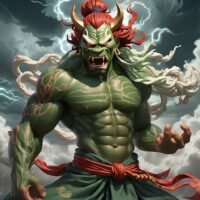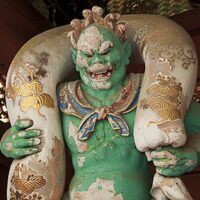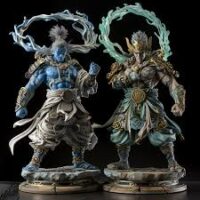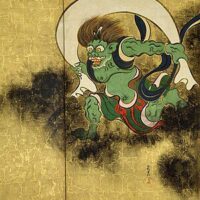Fujin : God of Wind
Listen
At a glance
| Description | |
|---|---|
| Origin | Japanese Mythology |
| Classification | Gods |
| Family Members | Izanami (Mother), Raijin (brother) |
| Region | Japan |
| Associated With | Winds, Destruction |
Fujin
Introduction
Fujin, a towering figure in Japanese mythology, is the deity of wind, wielding immense power over natural elements. Revered and feared, he embodies the raw forces shaping the world. This article explores Fujin’s character, from his physical depiction to his familial ties and enduring influence in modern times. He is a complex figure, both a force of creation and destruction, influencing weather patterns and affecting the outcomes of battles and crops. Fujin, also known as Fūjin or Fūten, remains one of the most iconic deities in the Shinto pantheon, embodying the elemental power of wind that shapes the world’s winds through his bag of air.
Physical Traits
Fujin’s appearance is as formidable as the winds he controls. Often depicted as an oni, he cuts an imposing figure with vibrant green skin and wind-whipped red and white hair. His face bears a permanent grimace, his wide eyes reflecting the untamed power he wields. His hulking physique, clad in a leopard-skin garment, completes the image. The most distinctive feature of Fujin is his colossal bag of wind slung over his shoulder—an inexhaustible source that grants him mastery over the air. From gentle breezes to devastating storms, he manipulates wind direction and intensity at will. Some portrayals depict the bag billowing with air, symbolizing the potential for tempestuous power. Notably, his hands often show four fingers each, representing the cardinal directions, underscoring his dominion over all corners of the world.
Family
Fujin’s origins are wrapped in mystery, with some accounts placing him among the primordial deities born from the chaos of creation. Another tradition suggests he emerged from the remains of the goddess Izanami, alongside his brother Raijin, the god of thunder and lightning. This association is enduring, as the two gods are consistently depicted together. In Japanese mythology, Fujin and Raijin’s relationship is marked by both cooperation and competition. Fujin’s winds enhance Raijin’s thunderbolts, creating powerful storms that sweep across the land. However, Fujin’s unpredictable nature sometimes clashes with Raijin’s focused fury, highlighting the dynamic balance between calm and chaos in nature.
Other names
Fujin, known primarily as the “wind god” in Japanese mythology, is recognized by several titles that offer insights into his diverse roles and attributes. One of his prominent names is Fūten (風天), which translates to “Heavenly Wind,” emphasizing his divine status and connection to the elemental forces that shape the heavens and earth. Another significant title is Kamikaze (神風), meaning “divine wind,” which historically refers to the powerful typhoons believed to have protected Japan from invading fleets. Though not exclusively tied to Fujin, this title underscores his influence over weather phenomena and his role in safeguarding the land.
Additionally, Fujin is referred to as Ryobu (両部), a lesser-known name that translates to “both aspects.” This title reflects the dual nature of his powers, capable of bringing both beneficial breezes and destructive storms. Across East Asia, Fujin’s influence extends beyond Japan into Chinese mythology, where he is known as Fēngbó. Here, he retains his essence as a wind deity, albeit with cultural adaptations that showcase his enduring significance and adaptable character in different mythological traditions. These various titles and representations highlight Fujin’s complex nature and widespread reverence across diverse cultural contexts.
Powers and Abilities
Fujin, revered as the god of wind in Japanese mythology, embodies a dynamic and omnipresent force in the natural world. Often most visibly active during storms and powerful typhoons, he commands winds that can topple trees and devastate structures. Beyond his role as a harbinger of destruction, Fujin also governs gentler breezes that offer relief and refreshment. His mastery over air currents spans from subtle zephyrs that cool the summer heat to tempestuous gales capable of reshaping landscapes. Moreover, Fujin’s influence extends into spiritual realms, where he is believed to guide departed souls on their journey to the afterlife, highlighting his dual role as both a force of nature and a guardian of spiritual transitions.
Central to Fujin’s divine authority is his unparalleled control over wind itself. Whether summoning nurturing breezes to aid crops or unleashing formidable gusts that alter terrain, he manifests his power riding atop a cloud, manipulating winds with gestures or through his inexhaustible bag. In Japanese mythology, wind is not merely a physical phenomenon but also a conduit for emotions and spirits. Thus, Fujin’s ability to stir emotions and influence battles by disrupting formations or carrying away arrows underscores his profound impact on both the physical and metaphysical realms.
Modern Day Influence
Fujin’s influence from ancient mythology continues to resonate strongly in modern culture, where his imagery and symbolism are prominently featured in art, literature, and popular media both in Japan and globally. Shrines dedicated to Fujin still draw worshippers seeking protection from natural disasters and blessings of favorable winds, highlighting his enduring significance in contemporary Japanese spiritual practices. In popular culture, Fujin frequently appears in video games, manga, and anime, often reimagined with new narratives and interpretations that captivate modern audiences. These adaptations ensure that Fujin’s legacy remains vibrant and relevant, portraying him not only as a symbol of nature’s power but also as a testament to humanity’s enduring fascination with the elements.
Fujin’s iconic presence transcends aesthetic appeal, serving as a poignant reminder of the delicate balance within nature itself. His depiction, embodying both the beneficial and destructive aspects of wind, mirrors the unpredictable forces that shape landscapes and influence climates. In an era increasingly focused on environmental consciousness, Fujin’s mythos offers a cautionary narrative about respecting and understanding the formidable forces of nature. Beyond Japan, Fujin’s image has been embraced and reinterpreted in various cultures, appearing in fantasy novels and video games worldwide. This widespread adoption underscores his universal appeal as a symbol of the power and mystery inherent in the wind, making him a timeless figure in global mythological traditions.
Related Images
Frequently Asked Questions
What is lorem Ipsum?
I am text block. Click edit button to change this text. Lorem ipsum dolor sit amet, consectetur adipiscing elit. Ut elit tellus, luctus nec ullamcorper mattis, pulvinar dapibus leo.
What is lorem Ipsum?
I am text block. Click edit button to change this text. Lorem ipsum dolor sit amet, consectetur adipiscing elit. Ut elit tellus, luctus nec ullamcorper mattis, pulvinar dapibus leo.
What is lorem Ipsum?
I am text block. Click edit button to change this text. Lorem ipsum dolor sit amet, consectetur adipiscing elit. Ut elit tellus, luctus nec ullamcorper mattis, pulvinar dapibus leo.
What is lorem Ipsum?
I am text block. Click edit button to change this text. Lorem ipsum dolor sit amet, consectetur adipiscing elit. Ut elit tellus, luctus nec ullamcorper mattis, pulvinar dapibus leo.
What is lorem Ipsum?
I am text block. Click edit button to change this text. Lorem ipsum dolor sit amet, consectetur adipiscing elit. Ut elit tellus, luctus nec ullamcorper mattis, pulvinar dapibus leo.












